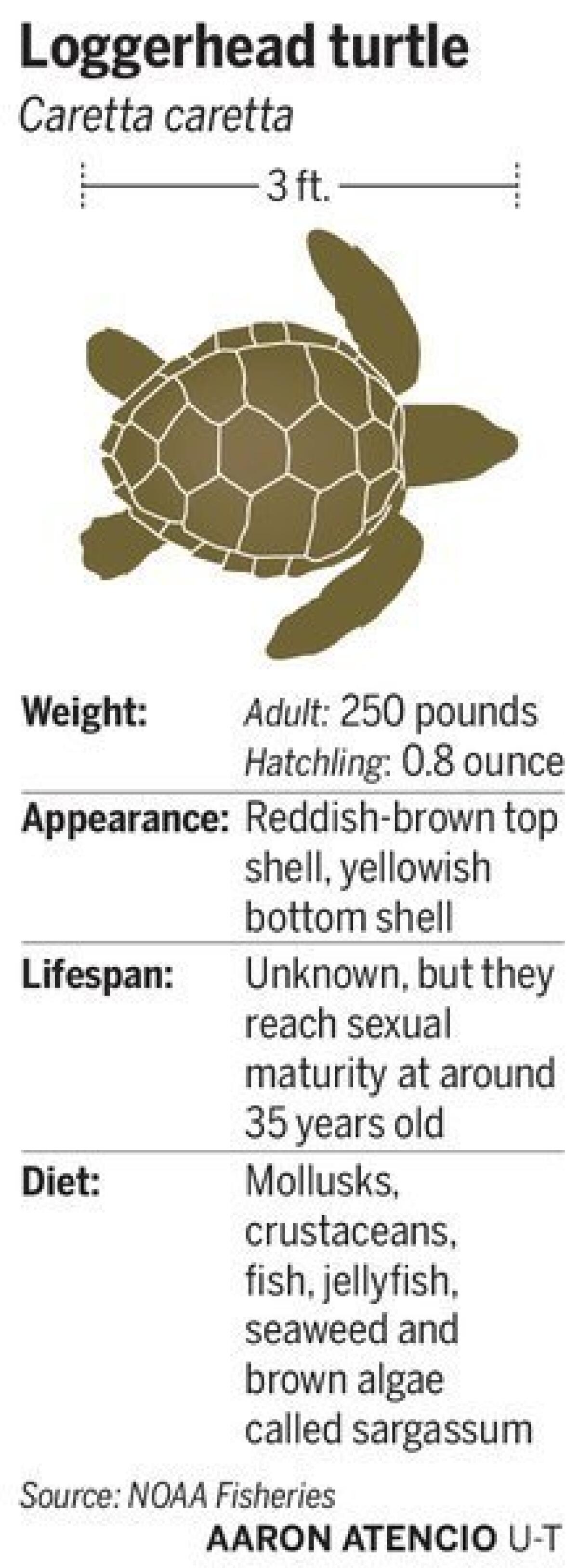Warmer waters bring loggerhead turtles to Southern California
As fishermen and scientists chase tropical tuna and marlin that have drifted into San Diego’s unusually warm waters during the last two years, they’ve encountered something else they’ve never seen: flotillas of loggerhead sea turtles bobbing off the California coast.
“This is the first account we’ve seen of so many loggerhead turtles in the history of scientific record,” said Jeff Seminoff, head of the marine turtle ecology and assessment program at the National Oceanic and Atmospheric Administration’s Southwest Fisheries Science Center in La Jolla.
The turtles’ arrival has enthralled recreational anglers but prompted restrictions on commercial fishing. And it’s launched a new line of exploration into the marine reptiles and the changing ocean they navigate.

With a spiky, reddish brown shell and bulky head that inspired their name, North Pacific loggerheads are global voyagers that typically travel hundreds of miles offshore. Hatchlings ride Pacific currents from nesting beaches in Japan to Baja, and then return to Japan as adults.
They can grow up to 250 pounds and 3 feet long at maturity, but the ones that have been spotted off Southern California range from the size of a dinner plate to a serving plate and are probably 1 to several years old.
Loggerheads — which were declared endangered five years ago — were rarely found in Southern California until 2014, when scientists began documenting large congregations swimming as close as 13 miles offshore.
The animals are acutely sensitive to temperature, and recent warm waters appear to have set them on a new route.
To find them, researchers conducted aerial surveys in a NOAA Twin Otter aircraft equipped with bubble windows on the sides and belly of the plane, which afforded better views of the ocean.
“It truly is the most amazing platform for aerial surveys of wildlife,” Seminoff said. “At 95 knots and 500 feet, we feel like we are crawling across the ocean’s skin when we are searching for turtles.”
During a survey in 2011, researchers didn’t see a single turtle. Last year they saw more than 200.
Along with the turtles, the unexpectedly warm waters have brought a host of other animals to Southern California: yellowtail, tuna and marlin among them. The presence of the sport fish has delighted anglers, but the turtles pose a problem for commercial fishermen.
See the most-read stories this hour >>
The National Marine Fisheries Service restricts the use of gillnets — vertical panels of netting used to catch swordfish, as well as thresher and mako shark, and opah — during certain ocean conditions. The presence or prediction of El Niño triggers the closures. In 2014, the closure took effect amid reports of injured loggerhead turtles stranding onshore, said Tina Fahy, a fishery biologist for NOAA.
“That is really rare to see loggerheads stranding off California,” she said. “We closed the fishery in July of 2014, and then had a full-blown El Niño in 2015, so we closed it for June, July and August. It seemed to have worked.”
As El Niño conditions wane, the closures probably will remain in effect at least through June, Fahy said. It’s uncertain whether the presence of turtles and other tropical species represents a fleeting visitation, or a new normal in an era of warming seas.
“That’s the billion-dollar question,” Seminoff said. “It’s possible that very subtle shifts in ocean temperature could be causing different assemblages of species. I’m not ready to wave the flag of climate change, but we’re asking those questions."
ALSO
Watch as red crabs cover the beaches of Orange County
River LA to hold first public listening session today in South Gate
Why did El Niño miss SoCal? It's complicated, National Weather Service says
Brennan writes for the San Diego Union-Tribune.
Sign up for Essential California
The most important California stories and recommendations in your inbox every morning.
You may occasionally receive promotional content from the Los Angeles Times.







